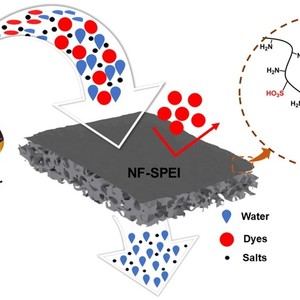Preparation of Highly Permeable Loose Nanofiltration Membranes Using Sulfonated Polyethylenimine for Effective ...
Citation
Jincheng Ding, Huiqing Wu*, and Peiyi Wu*. Preparation of Highly Permeable Loose Nanofiltration Membranes Using Sulfonated Polyethylenimine for Effective Dye/Salt Fractionation. Chem. Eng. J. 2020, 396, 125199.
Abstract
The sulfonated polyethylenimine (SPEI) was designed and employed to prepare high-performance loose nanofiltration (NF) membranes. A simple ring-opening reaction of polyethylenimine with 1,3-propanesulfonate (1,3-PS) was firstly conducted to synthesize SPEI. Then NF membranes were obtained by the cross-linked reaction between SPEI and trimesoyl chloride (TMC) via interfacial polymerization. Thanks to the restraining effect on interfacial polymerization from the sulfonic acid groups of SPEI, NF membranes with loose structures of surface layers as well as more negatively-charged and hydrophilic surfaces were prepared. The optimized loose nanofiltration membrane (NF-SPEI) presented high dye rejections to Victoria blue B, Congo red, Methyl blue and Reactive red 120 (all > 97%) and low salt rejections to Na2SO4 (8.40%) and NaCl (3.20%), meanwhile it presented a pure water flux as high as 411 L∙m-2∙h-1∙MPa-1. The NF-SPEI membrane also performed a good anti-fouling ability towards bovine serum albumin (BSA), humic acid (HA) and sodium alginate (SA). Moreover, a long-term performance stability of the membrane during the successive filtration process of dye/salt aqueous mixture was determined. Thus, this work offered a promising candidate SPEI for loose NF membrane’s development and application in textile wastewater treatment.


